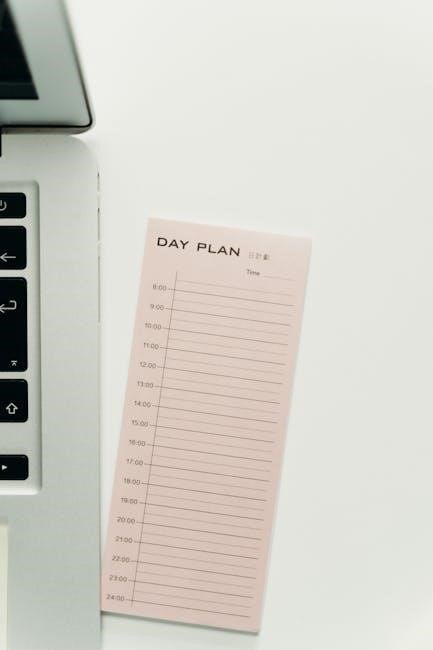What is the Daily Dozen?
The Daily Dozen, championed by Dr. Michael Greger, is a checklist of twelve food groups. This outlines the healthiest foods individuals should strive to consume daily. It’s a guide for optimizing health through diet. Focusing on whole, plant-based foods, it promotes nutrient-rich meals.

Dr. Greger’s Daily Dozen Checklist
Dr. Greger’s Daily Dozen checklist is a practical tool for tracking your daily intake of essential food groups. It features beans, berries, and other fruits. It also has cruciferous and green vegetables. You will also find nuts, seeds, and whole grains listed; This ensures comprehensive nutrition every day.
Food Groups in the Daily Dozen
The Daily Dozen comprises twelve essential food groups. These are designed to ensure a comprehensive intake of vital nutrients daily. The first group, beans, includes lentils, chickpeas, and soybeans. These are excellent sources of protein and fiber.
Next, berries offer antioxidants and vitamins. Choose blueberries, strawberries, or raspberries. Other fruits contribute additional vitamins and minerals. Apples, bananas, and oranges are good options.
Cruciferous vegetables, such as broccoli, cauliflower, and cabbage, are known for their cancer-fighting properties.
Greens, like spinach and kale, provide vitamins A and K. Other vegetables offer a variety of nutrients. Carrots, bell peppers, and tomatoes are great choices.
Flaxseeds are a source of omega-3 fatty acids. Nuts and seeds offer healthy fats and protein. Spices and herbs add flavor and antioxidants.
Whole grains provide fiber and energy. Brown rice, quinoa, and oats are recommended. Finally, beverages include water, unsweetened tea, and coffee. These are essential for hydration.
Regular exercise completes the Daily Dozen. This promotes overall health and well-being. By incorporating these food groups into your daily diet, you can achieve optimal health and vitality.

Benefits of Following the Daily Dozen
Following the Daily Dozen offers numerous health benefits; This dietary approach ensures a comprehensive intake of essential nutrients. It promotes overall well-being and vitality.
One key benefit is improved heart health. The emphasis on fruits, vegetables, and whole grains reduces the risk of cardiovascular diseases. These foods are rich in fiber, which helps lower cholesterol levels.
The Daily Dozen also supports weight management. Plant-based foods are generally lower in calories and higher in fiber. This combination promotes satiety and reduces overeating.
Furthermore, this dietary pattern enhances digestive health. The high fiber content aids in regular bowel movements and prevents constipation. A healthy gut microbiome is also fostered.
Incorporating a variety of fruits and vegetables boosts the immune system. These foods are packed with vitamins, minerals, and antioxidants. These protect the body against infections and diseases.
The Daily Dozen can also improve blood sugar control. Whole grains and legumes help stabilize blood glucose levels. This is particularly beneficial for individuals with diabetes.
Additionally, this dietary approach may reduce the risk of certain cancers. Cruciferous vegetables and berries contain compounds that inhibit cancer cell growth. Overall, the Daily Dozen promotes a healthier and longer life.
Daily Dozen Meal Planning: A Guide
Planning meals around the Daily Dozen is straightforward. Focus on incorporating the twelve food groups daily. Prioritize whole, unprocessed plant foods. Use Dr. Greger’s checklist as your guide. This ensures a balanced and nutritious diet.
Incorporating the Daily Dozen into Meal Prep
Meal prepping with the Daily Dozen simplifies healthy eating throughout the week. Start by identifying recipes that feature multiple Daily Dozen components. For instance, a lentil soup can cover beans, vegetables, and spices. Begin by planning your meals ahead of time, incorporating the twelve food groups into your daily diet. This proactive approach ensures you meet the recommendations outlined in Dr. Greger’s Daily Dozen checklist.
Next, dedicate a specific time each week to prepare ingredients. Chop vegetables, cook grains, and portion out nuts and seeds. Store these components separately to easily assemble meals. Consider making large batches of dishes like overnight oats with berries and flaxseeds for breakfast, or quinoa salads with leafy greens and chickpeas for lunch. These pre-made meals save time and ensure you’re consistently meeting your Daily Dozen goals.
Moreover, utilize the Daily Dozen app or a printable checklist to track your progress. This helps you identify any food groups you might be missing and adjust your meal prep accordingly. By incorporating the Daily Dozen into your meal prep routine, you can effortlessly maintain a balanced, plant-based diet, promoting optimal health and well-being. Remember, consistency is key to reaping the full benefits of this approach.
Daily Dozen App and PDF Resources
To assist individuals in adhering to the Daily Dozen guidelines, several helpful resources are available. The official Daily Dozen app, created by Dr. Michael Greger, is a user-friendly tool for tracking your daily intake of each food group. It features a checklist where you can mark off servings as you consume them, providing a visual representation of your progress. The app is available for both iPhone and Android devices, making it accessible to a wide audience. It also offers educational information about the benefits of each food group, helping users understand the rationale behind the recommendations.
In addition to the app, PDF resources are readily available online. These PDFs often include a printable checklist that you can use to manually track your Daily Dozen intake. Some PDFs also provide meal planning guides, recipe ideas, and shopping lists to further simplify the process. These resources are particularly useful for individuals who prefer a tangible tracking method or want to have a reference guide on hand. You can find these PDFs on various websites, including Dr. Greger’s NutritionFacts.org and other health-focused platforms.
These digital and printable resources empower individuals to easily incorporate the Daily Dozen into their daily routines, fostering healthier eating habits and promoting overall well-being.

Sample Daily Dozen Meal Plan Ideas
Incorporating the Daily Dozen into your daily meals can be both simple and delicious. For breakfast, consider a smoothie with berries, spinach, flaxseeds, and a banana. Add a serving of nuts or seeds for extra nutrients. Lunch could feature a hearty salad with mixed greens, chickpeas, chopped vegetables like bell peppers and cucumbers, and a tahini dressing. Include a serving of whole grains, such as quinoa or brown rice, to complete the meal.
Dinner options are equally versatile. A lentil soup packed with diced carrots, celery, and onions provides a serving of beans and vegetables. Serve it with a side of steamed broccoli and a whole-grain roll. Alternatively, try a stir-fry with tofu, cruciferous vegetables like Brussels sprouts and kale, and a variety of other colorful vegetables. Season with herbs and spices for added flavor.
Snacks can also contribute to your Daily Dozen goals. An apple with almond butter, a handful of berries, or a small bowl of edamame are all excellent choices. Remember to include a source of vitamin B12 through supplementation or fortified foods to ensure optimal nutrition. These are just a few ideas to get you started; feel free to experiment and create your own Daily Dozen-inspired meals based on your preferences and dietary needs.

Where to Find Daily Dozen Meal Plan PDFs
Locating Daily Dozen meal plan PDFs is easier than ever, thanks to numerous online resources dedicated to plant-based nutrition. Dr. Michael Greger’s NutritionFacts.org often features downloadable guides and resources, including PDFs outlining the Daily Dozen and providing meal planning suggestions. These resources offer a comprehensive overview of the food groups and serving sizes to aim for each day.
Many websites and blogs focused on vegan and vegetarian lifestyles also offer free Daily Dozen meal plan PDFs. These resources often include sample meal plans, recipes, and tips for incorporating the Daily Dozen into your daily routine. Some apps dedicated to healthy eating may also provide downloadable PDFs or printable checklists to help you track your progress.
Additionally, consider searching online health and wellness forums or groups, where members often share their own Daily Dozen meal plans and resources, including PDFs they have created or found helpful. Remember to verify the credibility of the source and ensure that the information aligns with Dr. Greger’s recommendations before implementing any meal plan. By exploring these various avenues, you can easily find a Daily Dozen meal plan PDF that suits your individual needs and preferences.

